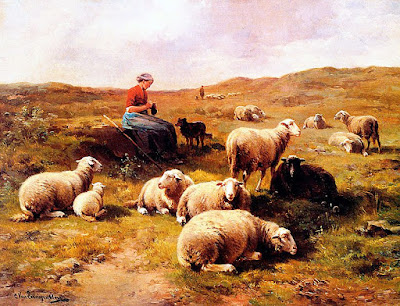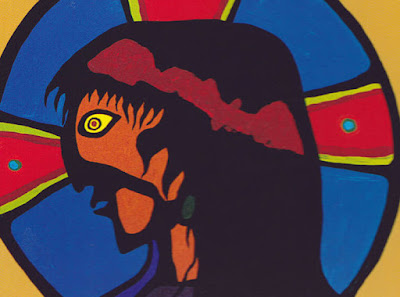 |
| A Shepherdess with her flock, Cornelius van Leemputten, 1841-1902 |
So I've been thinking about whether there were any female shepherds at the nativity.
The thought arose because a female friend recently asked a question I had never considered before: Why are all the shepherds in Christmas creches men?
The thought arose because a female friend recently asked a question I had never considered before: Why are all the shepherds in Christmas creches men?
A quick look at our own creche showed she was right; both shepherds are male.
My friend went on to suggest that, back in Jesus’ day, women also watched the flocks; it wasn't just men. So why don't women appear in our holiday creches or Christmas pageants?
After all, Luke doesn't say whether the shepherds were men or women; he ascribes no gender to them.
Faced with the question, I did what everyone does in a situation like this: I Googled it.
My friend went on to suggest that, back in Jesus’ day, women also watched the flocks; it wasn't just men. So why don't women appear in our holiday creches or Christmas pageants?
After all, Luke doesn't say whether the shepherds were men or women; he ascribes no gender to them.
Faced with the question, I did what everyone does in a situation like this: I Googled it.
The
first website that came up was Christians for Biblical Equality (CBE), an organization that believes the Bible,
properly interpreted, teaches the equality of women and men.
In an
article titled The Way of a Shepherd, author Beulah Wood—who grew up on a sheep farm
and looked after them herself—says that “possibly
half the shepherds in Jesus’ day were women, and probably half the shepherds of
the world today.”
She
goes on to note that we first meet Rachel as a shepherd in Genesis 29:6-9. (“Rachel
came with her father’s sheep for she was their shepherd.”)
We
are also introduced to Zipporah as a shepherd in Exodus 2:16: “Now a priest of
Midian had seven daughters and they came to draw water and fill the troughs to
water their father’s flock.”
Says
Wood: “These matriarchs of Israel both met their husbands at wells where they
led their flocks to drink. During the course of their daily work, the contact
occurred that led to their marriages and many more years of caring for flocks.”
Next
up was Women From the Book blog, by Karen
Meeker. He goal is to bring to life the “scores of women who appear within the
pages of the Bible.”
In
a post titled Life as a Shepherdess, Meeker says “in
ancient Israel it was not unusual for women to work outside the home, young
women at least. When a girl was eight to ten years old, she began leading the
family herd out to nearby pasture.”
At the end
of the day, she says, “the shepherdess brought her sheep back home. At night
the animals were housed in stone-walled pens attached to buildings or
compounds, or on the ground floor of houses in the cities, or corralled in
thorny, fence-like enclosures typical of nomadic enclosures.”
Tending
the family herd “was reserved primarily for girls, and they continued this work
until married at age fifteen or sixteen,” she adds.
When
local grass was insufficient, she says that “men took the herds further afield
. . . women worked close to home.”
In
another blog post titled Could the Shepherds Who Visited Jesus Been Women?, Tracy J. Robbins poses an
interesting question:
Considering Jesus’s revolutionary way (for his time) of
including women, why not have women be the first to see the arrival of God on
earth, just as they were the first to see the resurrected Jesus?
Admittedly,
there isn’t a lot of evidence to say women were present at the birth of Jesus.
But there also isn’t any way to say conclusively they weren’t.
The Bible doesn't say anything about it, one way or the other.
The Bible doesn't say anything about it, one way or the other.
But
what we can say for sure is that, over the centuries, women have been marginalized
women in the Christian religion—their roles in the Gospels and the New
Testament downplayed, prevented from being leaders, and forced into stereotypical gender roles.
So
even if it can’t be proved women were there, maybe it’s time to promote a little
gender balance in the Christmas story.
Perhaps at future Christmas pageants we will see some female shepherds.
And in the spirit of goodwill, some female magi wouldn’t hurt, either.
And in the spirit of goodwill, some female magi wouldn’t hurt, either.

